The Slider Bags Market is estimated to be valued at USD 16.4 billion in 2025 and is projected to reach USD 28.3 billion by 2035, registering a compound annual growth rate (CAGR) of 5.6% over the forecast period.
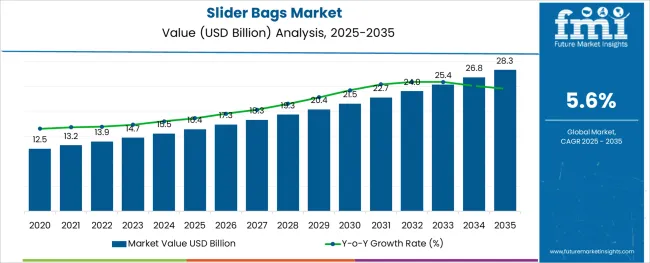
The slider bags market is experiencing consistent growth driven by the demand for resealable and user friendly packaging solutions across food, pharmaceutical, and household segments. The rise in consumer preference for portion controlled, spill resistant, and reusable storage options has reinforced the appeal of slider mechanisms that ensure ease of use and secure sealing.
Regulatory emphasis on reducing single use plastic waste and enhancing packaging sustainability has prompted manufacturers to innovate with recyclable and low impact materials while retaining product durability. Technological advancements in flexible packaging equipment and customization capabilities have expanded the applicability of slider bags in e commerce and specialty retail.
As convenience, hygiene, and storage efficiency continue to shape consumer behavior, the market outlook remains strong with significant opportunities in premium packaging, travel packs, and value added storage formats.
The market is segmented by Material, Capacity, and End Use and region. By Material, the market is divided into Plastic, Paper, and Aluminium. In terms of Capacity, the market is classified into Up to 2 Oz, 3 Oz to 5 Oz, 6 Oz to 10 Oz, and Above 10 Oz.
Based on End Use, the market is segmented into Food, Cosmetic and Personal care, Pharmaceutical, and Others (Electronics, Automotive, etc.). Regionally, the market is classified into North America, Latin America, Western Europe, Eastern Europe, Balkan & Baltic Countries, Russia & Belarus, Central Asia, East Asia, South Asia & Pacific, and the Middle East & Africa.
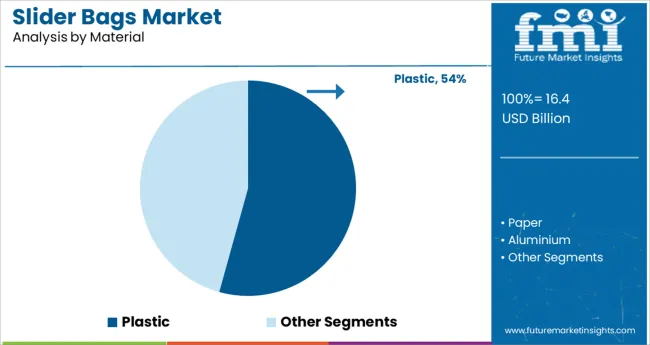
The plastic material segment is expected to account for 54.30% of the total market revenue by 2025, making it the leading material category. Its dominance is driven by the widespread availability, cost efficiency, and durability of plastic resins such as polyethylene and polypropylene, which are ideally suited for flexible slider bag applications.
Plastic allows for lightweight construction, moisture resistance, and ease of customization, all of which are essential for packaging perishable goods and non food items. Furthermore, advances in recyclable and biodegradable plastic blends have enabled compliance with evolving environmental standards without compromising product integrity.
As a result, plastic remains the preferred material in this market, offering the right balance of performance, versatility, and cost effectiveness.
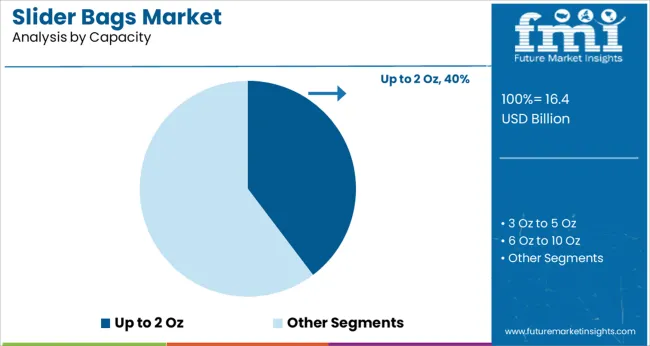
The up to 2 oz capacity segment is projected to hold 39.70% of total market revenue by 2025 under the capacity category, establishing it as the dominant size format. This segment caters to growing demand for compact and single use packaging across snacks, condiments, pharmaceuticals, and personal care items.
Its popularity is supported by convenience focused consumption habits and the proliferation of sample size offerings in modern retail. Lightweight and portable, this capacity range is particularly well suited for travel packs, school lunches, and portion controlled servings.
Additionally, the format aligns well with e commerce logistics and shelf optimization requirements, driving adoption among brands seeking efficient and flexible packaging. The combination of consumer convenience, operational efficiency, and market adaptability continues to position this segment as the market leader in slider bag capacities.
The global slider bags market witnessed a growth rate of 5.1% CAGR during 2020 to 2024 and reached USD 15.5 Billion in 2024.
Slider bags falls under the type of zipper packaging bags. Slider bags are transparent, inexpensive, rectangular storage flexible packaging bags that come with a slider for opening and closure. Slider bags are mostly made of plastic and paper.
Consumers find zipper bags difficult to use as the zipper can be easily damaged or broken while opening or closing the bag over and again. Because of this, these bags cannot be reused multiple times. Therefore, slider bags is best suitable packaging option as slider bags provide more life to the bags and can be used multiple times.
These bags are convenient to open and close by multiple times without hampering the zipper and it improves the service life of the bag. These slider bags provide more value and freshness to the products which can prove to attract more consumers compared to another packaging. These factors accelerate the growth of the slider bags in the packaging market over the globe.
There are multiple types of slider bags available in the market according to the storage capacity such as up to 2 Oz, 3 5 Oz, 6 10 Oz and above 10 Oz. Slider bags prove to be a great option for small and medium commodities. A lot of e-commerce companies opt for these slider bags for packaging different clothing, food, beauty, and personal care products.
The slider bags can store and protect the products kept in them from any external factor such as weather conditions. There are multiple types of slider bags available in the market.
The lightness and cost effectiveness of the slider bags makes it a suitable product in the packaging market. Slider bags are mostly used by the food industry to keep the product safe and fresh. Thus, the food and personal care industry segments create a lot of future opportunities for slider bags.
A lot of brands are moving towards the flexible packaging solutions such as slider bags and pouches from the traditional rigid packaging for their products.
The main reasons for this shift are a considerable reduction in production costs and an improvement in transportation efficiency. Slider bags made from Kraft paper being environment friendly and natural ways of packaging products and commodities have become the choice of packaging for many brands to cover the future market.
A lot of problems arising with plastic packaging solutions generating more and more plastic waste and considering the environmental footprint in the future slider bags made from paper are the future of the packaging sector.
The food segment is projected to hold around 45% of the global slider bags market by the end of 2025. Consumers want to avoid food waste and retain all the nutritional and taste qualities of the purchased product. To prevent the flavour from fading and to ensure that the food retains its freshness, it is necessary to opt for perfectly adapted packaging.
Frozen foods are being consumed by a lot of the population. Consumers have become health conscious and all types of fruits and vegetables are being demanded by the consumer.
To fulfil the consumer requirements of a variety of products, the frozen food market is expecting to grow more in the future, and in this case, slider bags packaging can be a very cost-efficient and convenient packaging option.
The application of slider and zipper packaging bags in frozen food applications can prove to cover a major portion of the global market. Slider bags are used as the primary packaging solution for storing frozen foods such as vegetables, french fries, pizza, and other ready-to-eat items before applying the secondary packaging of other materials such as cardboard.
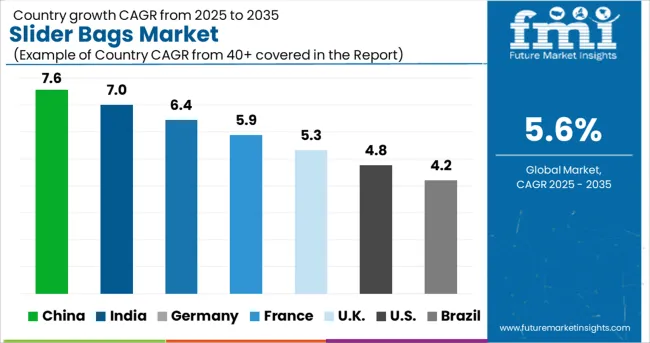
German slider bags market is projected to grow 1.6 times the current market value during the forecast period. According to the data published by European Commission, a survey conducted shows that 60% population falling in the age group of 16yrs to 74yrs does online shopping in the year 2020. The number of people doing online shopping has increased by 2X from 32% in comparison with 2009.
Women online shoppers share sharply increased from 29% to 59% whereas men's online shoppers rise from 35% to 61% over ten years. In Europe, Germany has 79% share increment in online shoppers in the last ten years. This is projected to create a growth opportunity for the slider bags market.
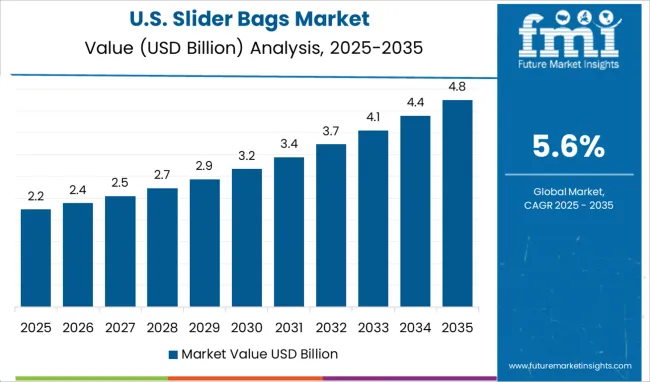
The USA is estimated to hold major portion of the North American slider bags market during the forecast period. According to the data provided by the National Centre for Health Statistics (NCHS), around 50% of the population of the united stated consumes fast food daily receding from the age of 20 to 39 yrs.
This contributes to the most number of youngster population in the country which can create a target market. This can fuel the growth of the slider bags market in the USA. being the most convenient to use and can easily be operated by the young-age as well as old-age population in the country.
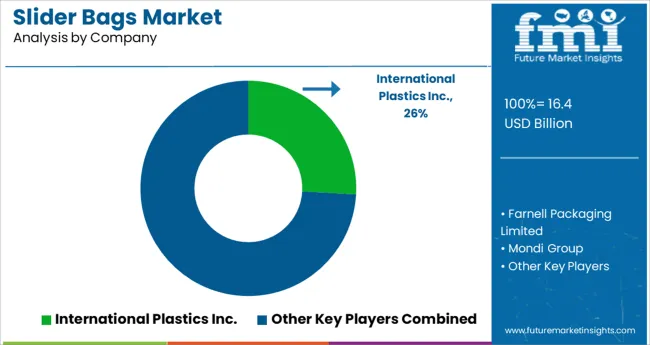
The key players operating in the slider bags market are trying to adopt partnership strategy to expand their market presence and resources. Also, the company are trying to focus on product launch to capture the market. Some of the latest development by the key players include-
| Attribute | Details |
|---|---|
| Growth Rate | CAGR of 5.6% from 2025 to 2035 |
| Base Year for Estimation | 2024 |
| Historical Data | 2020 to 2024 |
| Forecast Period | 2025 to 2035 |
| Quantitative Units | Revenue in USD Million, Volume in Units and CAGR from 2025 to 2035 |
| Report Coverage | Revenue Forecast, Volume Forecast, Company Ranking, Competitive Landscape, Growth Factors, Trends and Pricing Analysis |
| Segments Covered | Material, Capacity, End Use, Region |
| Regions Covered | North America; Latin America; Europe; East Asia; South Asia; Middle East and Africa (MEA); Oceania |
| Key Countries Covered | USA, Canada, Mexico, Brazil, Germany, UK, France, Italy, Spain, Russia, China, Japan, India, GCC countries, Australia |
| Key Companies Profiled | International Plastics Inc.; Farnell Packaging Limited; Mondi Group; Biolegeen Biodegradable Material Technology Co.; VWR International, LLC.; Great America Packaging; Glenroy, Inc; Flexico Group; Sarkina; Elke Plastic GMbh; Dove Technologies; Montage; Reynolds Group Holdings Limited; Global Packaging Solutions; Artisans Pack; Four Star Plastic; ALLIEDFLEX Technologies, Inc; Balaji Flexipack; Wuxi Tyler Packaging Products Co.,Ltd; SVP Packaging Private Limited; Thantawan Industry Plc.; Com-Pac International |
| Customization & Pricing | Available upon Request |
The global slider bags market is estimated to be valued at USD 16.4 USD billion in 2025.
It is projected to reach USD 28.3 USD billion by 2035.
The market is expected to grow at a 5.6% CAGR between 2025 and 2035.
The key product types are plastic, paper and aluminium.
up to 2 oz segment is expected to dominate with a 39.7% industry share in 2025.






Full Research Suite comprises of:
Market outlook & trends analysis
Interviews & case studies
Strategic recommendations
Vendor profiles & capabilities analysis
5-year forecasts
8 regions and 60+ country-level data splits
Market segment data splits
12 months of continuous data updates
DELIVERED AS:
PDF EXCEL ONLINE
Evaluating Slider Bags Market Share & Provider Insights
Slider Pouches Market Size and Share Forecast Outlook 2025 to 2035
Market Share Insights for Slider Pouches Providers
Polybags Market Size and Share Forecast Outlook 2025 to 2035
Net Bags Market
VCI Bags Market
Sandbags Market
Leno Bags Market Size and Share Forecast Outlook 2025 to 2035
Silo bags Market Size and Share Forecast Outlook 2025 to 2035
Food Bags Market Share, Size, and Trend Analysis for 2025 to 2035
Competitive Breakdown of Silo Bag Manufacturers
Paper Bags Market Size and Share Forecast Outlook 2025 to 2035
Jumbo Bags Market Size and Share Forecast Outlook 2025 to 2035
Blood Bags Market Size and Share Forecast Outlook 2025 to 2035
Craft Bags Market Growth, Trends, Forecast 2025 to 2035
Market Share Breakdown of Craft Bags Manufacturers
Competitive Breakdown of Paper Bags Providers
Market Share Analysis of Jumbo Bags & Key Players
Grout Bags Market Demand & Construction Industry Trends 2024 to 2034
Sugar Bags Market

Thank you!
You will receive an email from our Business Development Manager. Please be sure to check your SPAM/JUNK folder too.
Chat With
MaRIA